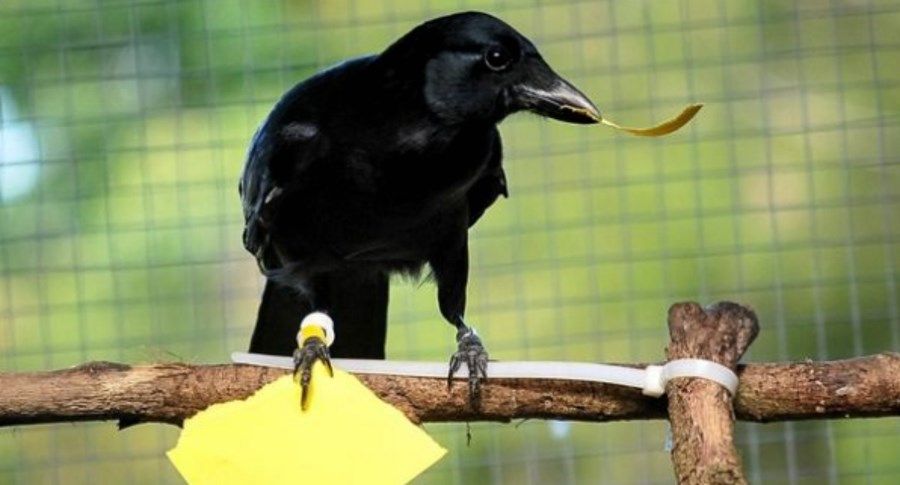Unusual abilities of the bearded crow. Can produce tools from memory
Bearded crows are extremely intelligent birds. Researchers had already observed in them the ability to make and use sophisticated tools. New research indicates that these birds have template patterns in their minds and can use them to make tools from available materials.
Late last year in the pages of the journal „Current Biology” research on bearded crows has emerged. It is an endemic species to New Caledonia and the Loyalty Islands – Islands in the western Pacific Ocean, whichory infuriated the researchers. They noticed how these birds perform one of the most sophisticated designsoin tools – sticks with a neatly shaped hooked endowce. They used them to get food. They are the only species besides humans thatory can make hook-ended tools. For more on this topic, in the text: crows know how to make good tools.
Now the researchers have determined that bearded crows use memorized images of the tools they use to then, when necessary, produce a tool from available materialow. Research on the subject appeared in the journal „Scientific Reports”.
– We are finding evidence of a particular type of emulation, whichorą is called template matchingoin mental. MoIn simpler terms, crows can replicate tool designs using only a mental image of that tool – said Alex Taylor of the University of Auckland.
Researchers have been asking for years how many of the bearded crows’ abilities are genetically programmed, and what proportion of them are acquired and passed on through learning and memorization.
In a famous experiment conducted and recorded in 2002 by scientistsoat the University of Oxford, a crow named Betty was able to bend a straight piece of wire to create aob tool ended with a hook. This allowed it to get to its favorite treat – A piece of pig’s heart. The feat was hailed as a proof ofod on that bearded crows can invent new tools on the spot. This is a rarely observed ability amongod animals.
In a study published a dozen years poIt later turned out that more than a dozen wild crows rown also plucked small twigs and shaped them into tiny hooks, which led to someorych researchers to conclude that this ability is at least partially encoded in genes. Others claim that the birds mimic the techniques observed. Taylor takes a slightly different approach.
– It can be cfoknow up to twooch methods of making paper airplanesow. One can follow the list of indicatedowek – zlo¿ in the middle and then bend the corners, etc. or have an idea of what the plane should look like at the end and work toward that goal – explained Taylor.
To gain confidence in the validity of his thesis, Taylor, along with coohe captured eight wild crows for a rather peculiar experiment. The researchers created something like a vending machine for the crows – A popular vending machine that sells coffee or candy bars. The crows were trained that for a properly sized piece of paper they could get treats in the vending machine.
In the second phase of the experiment, once the birds had learned how the machine worked, the combinedoł scientistow gave them a piece of paper too large to fit into the vending machine. The researchers were curious whether crows themselves would be able to adjust pieces of paper to size, for which theyorą previously received the award. Crows passed the exam.
– We tested whether the crows remembered what size paper worked and whether they were able to produce it themselves – said Sarah Jelbert of the University of Cambridge, whoora has developed a vending machine for crows. – All adult birds spontaneously created the right size card for their vending machine – admitted.
– The crows were able to reproduce the designs of the tools (whichors in this case were appropriately sized pieces of paper) without a reference point – there was no tool, ktore could see by making a tool out of paper,” Taylor said, adding that the only way the birds could reproduce the objects was through mental wzor draft tools in their mind.
Taylor thinks, however, that crows have proven something else. They have shown that they can learn from each other zaroboth in the manufacture and use of tools. And here we are talking no longer about biology, but about culture. Admittedly, the behavior was not observed, ktore would indicate that the birds are copying each other’s behavior, at least in this wayob how a human child can copy a teacher or parent.
– Cumulative cultural evolution is natural selection ideaow – we copy the best ideas and then modify them. Someore of these modifications work, someore not, and the best ones are then copied and passed on to the – explained Taylor.

